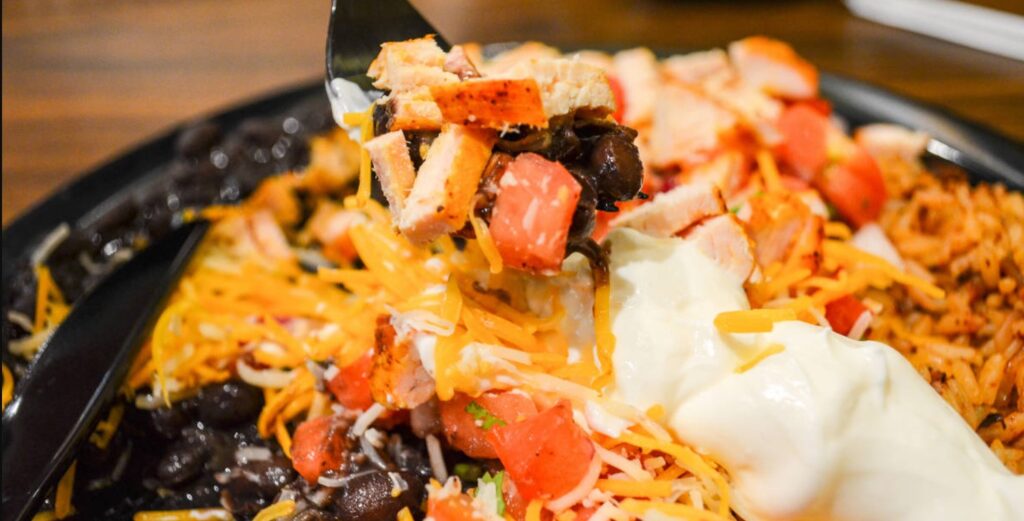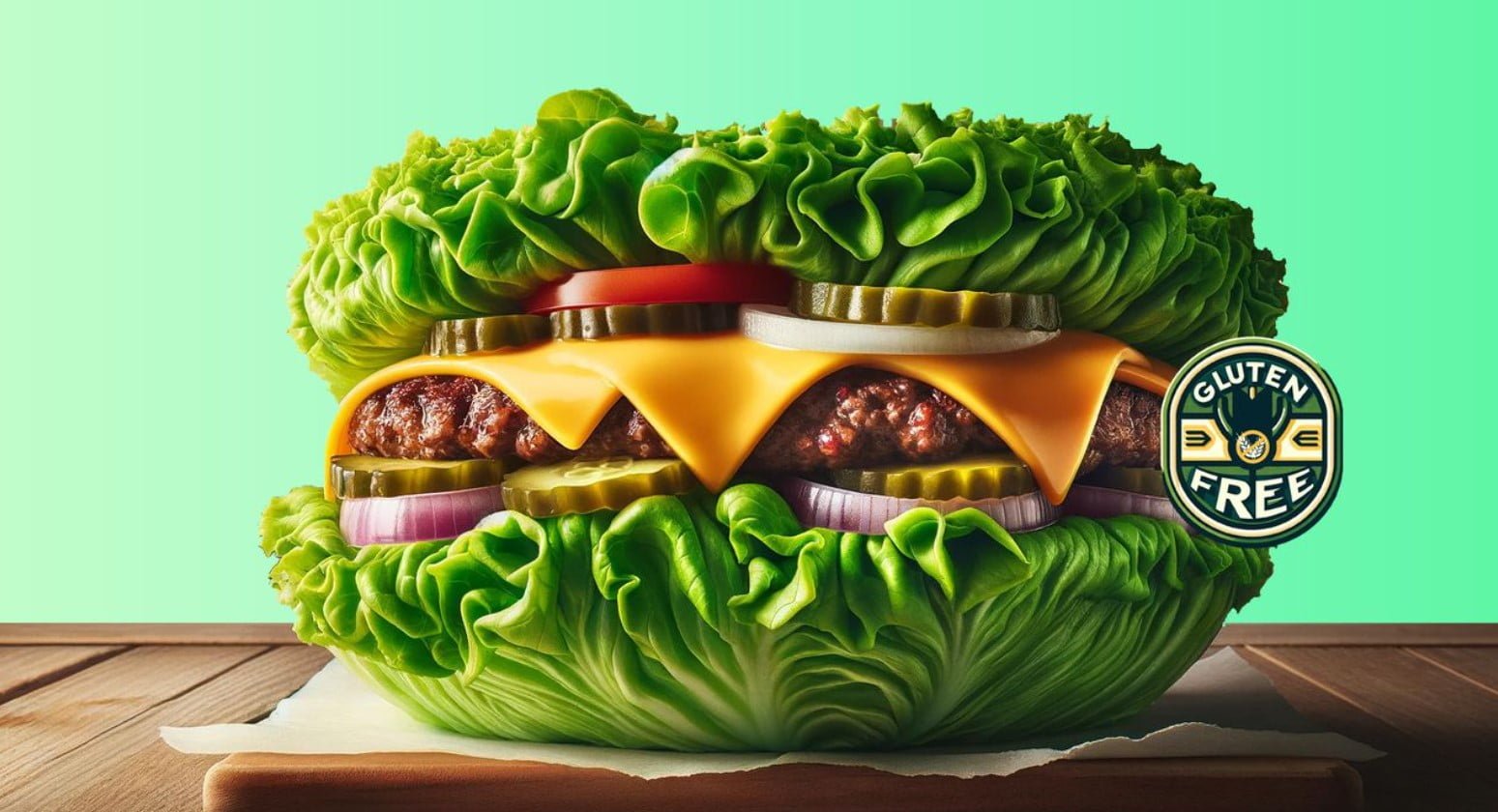Are you constantly on the go but struggling to find quick meal options that cater to your gluten-free lifestyle? Fear not! The fast-food landscape is changing, and we’re here to steer you through the bustling drive-thrus and neon menus to the promised land of gluten-free goodness
Understanding Gluten-Free

Gluten, a protein present in certain grains like wheat, barley, rye, and triticale, serves as a binding agent in food preparation, providing elasticity to doughs and baked goods. While harmless for most individuals and a component of many nutritious foods, gluten can pose health challenges for some. Moreover, Celiac disease, an autoimmune condition, results in intestinal damage upon gluten ingestion, manifesting symptoms like bloating, diarrhea, and malnutrition.
Gluten sensitivity, akin to celiac disease but lacking the autoimmune response, can also cause adverse reactions. Also, Those afflicted with these conditions must adhere to a gluten-free diet to manage symptoms effectively. Others may opt for gluten avoidance based on personal dietary choices or health considerations.
“The gluten free diet taught me to cook. Now cooking is my hobby and a part of my routine to stay fit and healthy.”
Why Gluten-Free?

Let’s first discuss why someone could take this course of action before getting into the juicy (but gluten-free!) specifics. Also, Grain-free eating doesn’t have to mean giving up on fast food convenience if you’re going gluten-free for health reasons, celiac illness, or just personal preference.
In fact, For some people, adopting a gluten-free diet is essential, while for others, it is a choice. So, Here’s a closer look at the motivations behind avoiding gluten:
Health Conditions
• Celiac Disease: Gluten, a protein present in wheat, barley, and rye, is the cause of an autoimmune condition. Consuming gluten can harm the small intestine in people with celiac disease, which can cause problems with nutrient absorption and a variety of other symptoms.
• Non-Celiac Gluten Sensitivity (NCGS): People with NCGS may have symptoms like headaches, bloating, and abdominal pain, but they do not have the intestinal damage associated with celiac disease.
• Wheat Allergy: Restricting gluten consumption can assist those with wheat allergies to avoid allergic reactions, which can range in severity from minor to fatal.
Dietary Choices
• Perceived Health Benefits: Although there isn’t always scientific proof to back up these claims, some people stick to a gluten-free diet because they think it’s healthier or might help them lose weight.
• Inflammatory illnesses: Some people choose to follow a gluten-free diet to manage inflammatory illnesses because they believe gluten may exacerbate inflammation.
Lifestyle
• Needs of the Family and Household: To lower the risk of cross-contamination, the entire family may go gluten-free if one member has a gluten-related condition.
• Dietary Trends: Going gluten-free is now associated with a larger movement towards “conscious” eating, in which people focus more intently on the components of their food.
Pro Tip: Remember that, not everyone benefits from a gluten-free diet; rather, people with wheat allergies or celiac disease must follow this diet by medical necessity. For others, it comes down to personal preference and how gluten affects their bodies. Seeking advice from a healthcare expert is recommended if you’re thinking about going gluten-free to make sure you’re making the best decision for your health.
The Safe Picks
- McDonald’s: They offer burger options without the bun, lettuce-wrapped burgers, salads, a gluten-free McFlurry with M&M’s, and a Fruit ‘N Yogurt Parfait.
- Burger King: Gluten-free choices include a bun-less Whopper, grilled chicken sandwich, garden fresh salad, and soft-serve ice cream with various sauces.
- Wendy’s: Gluten-sensitive options feature burgers without the bun, salads without chicken and croutons, chili, baked potatoes with assorted toppings, and their renowned Frosty.
- Chick-fil-A: They use separate oil for their waffle potato fries, reducing the risk of cross-contamination with breaded chicken.
- Panera Bread: Offers a variety of salads and other customizable items suitable for a gluten-free diet.
- Chipotle: Nearly all menu items can be made gluten-free, except for the flour tortillas.
- Taco Bell: While they provide some gluten-free choices, caution is advised regarding cross-contamination.
- Arby’s: Gluten-free meats are available, though cross-contamination should be considered.
- Sonic: While they offer gluten-free options, confirming with staff is recommended to ensure they align with dietary needs.
- Five Guys: Options include burgers served in a bowl or wrapped in lettuce instead of a bun.
- KFC: Certain chicken options are gluten-free, but cross-contamination risks should be assessed.
- Popeyes: Some items are gluten-free, but there’s a risk of cross-contamination.

Pro Tip: Although these establishments provide gluten-free options, please be aware that cross-contamination can occur, particularly in fast-food venues. However, It’s always best to let the staff know about any dietary restrictions you may have and to find out how they prepare food to make sure your meal fits your gluten-free diet.
Gluten-Free Fast Food Challenge & Cross-Contamination Conundrum
The Gluten-Free Fast Food Challenge is a real hurdle for those who need or choose to avoid gluten in their diets. In addition, Navigating fast food menus can be tricky when you’re avoiding gluten. Cross-contamination, hidden gluten sources, and limited options can turn your quick meal into a risky business. But don’t worry, we’ve got the tips and tricks to keep you safe and satisfied. Here’s a breakdown of the challenges and some strategies to overcome them:

What is Cross-Contamination?
The unintentional spread of germs or pollutants from one surface to another, frequently as a result of careless handling, is known as cross-contamination. Moreover, It can happen at many stages of food production, from fields to kitchen preparation, which makes it essential. Food-to-food, equipment-to-food, and people-to-food are the three primary categories.
Cross-contamination in gluten-free fast food is particularly problematic since even trace amounts of gluten from gluten-containing items can trigger symptoms in those with celiac disease or gluten sensitivity. Also, To reduce this danger for their gluten-free offerings, many fast-food restaurants have put in place processes.
Tips for avoiding cross-contamination at fast-food
- Shared Cooking Spaces: Many fast-food restaurants use the same grills, fryers, and prep areas for all their food, which can lead to gluten-containing particles mixing with gluten-free items.
- Utensils and Equipment: The same utensils may be used for both gluten-containing and gluten-free foods, further increasing the risk of cross-contamination.
Strategies to Overcome Cross-Contamination
- Ask Questions: Don’t hesitate to ask the staff about their cross-contamination prevention practices.
- Go for Dedicated Gluten-Free Options: Some chains have specific menu items or dedicated areas for preparing gluten-free food.
Hidden Gluten Sources
- Sauces and Condiments: Many sauces, dressings, and condiments contain gluten as a thickener or flavor enhancer.
- Breading and Batter: Even if the main ingredient is gluten-free, the breading or batter might not be.
Strategies to Avoid Hidden Gluten
- Check Ingredients: Always check the ingredient list for hidden sources of gluten.
- Request Modifications: Ask for your food to be prepared without sauces or breading that may contain gluten.
Limited Options
- Menu Restrictions: Gluten-free options are often limited, which can make dining out less enjoyable.
- Lack of Variety: Repeatedly eating the same gluten-free items can become monotonous.
Strategies to Expand Options
- Explore Different Chains: Different fast-food chains may offer unique gluten-free items.
- Customize Your Order: Get creative with the menu by customizing orders to fit your dietary needs.
Communication is Key
- Be Clear About Your Needs: When ordering, be explicit about your gluten-free requirements.
- Educate Yourself: The more you know about gluten-free diets and options, the better you can communicate your needs.
The Hidden Gluten

Here are some common fast-food items that may unexpectedly contain gluten and ingredients to watch out for
Common Fast-Food Items That Surprisingly Contain Gluten
- Kinds of pasta like ravioli, dumplings, couscous, and gnocchi.
- Noodles such as ramen, udon, soba (unless made with 100% buckwheat flour), chow mein, and egg noodles.
- Breads and pastries like croissants, pita, naan, bagels, and muffins.
- Baked goods including cakes, cookies, pie crusts, and brownies.
- Cereals and granola often contain malt extract or flavoring.
- Breakfast foods like pancakes, waffles, French toast, crepes, and biscuits.
- Breading and coating mixes like panko breadcrumbs.
- Sauces and gravies thickened with wheat flour.
- Flour tortillas and other products are made with wheat flour.
Ingredients to Beware of
- Wheat varieties and derivatives like wheatberries, durum, semolina, spelt, farina, and graham.
- Gluten-containing grains such as rye, barley, and triticale.
- Malt forms like malted barley flour, malt extract, malt syrup, and malt vinegar.
- Brewer’s yeast and wheat starch that hasn’t undergone gluten removal processing.
Pro Tip: It’s crucial to scrutinize labels and inquire about ingredients, particularly if you have gluten sensitivity or celiac disease. Here, Many fast-food chains now offer gluten-free alternatives, so it’s wise to explore their menus for safer options. Remember, even foods not listing gluten-containing ingredients can risk cross-contamination, so proceed with caution.
Chain-Specific Guides
Here’s a rundown of gluten-free options at major fast-food chains, along with their pros and cons:
Gluten-Free Offerings
- Chick-fil-A: Offers a comprehensive gluten-free menu, featuring grilled chicken nuggets, sides, dipping sauces, and gluten-free buns made from ancient grains.
- Arby’s: Provides a sizable gluten-free menu, with most items being gluten-free when consumed without bread. However, caution is advised regarding potato-based foods due to potential cross-contamination.
- Chipotle: Except for the soft flour tortilla, all items are gluten-free, making it a safe choice for those with celiac disease.
- McDonald’s: Gluten-free options include fruit parfaits, yogurt snacks, salads, and burgers that can be ordered without the bun.
- In-N-Out Burger: Burgers are gluten-free when ordered without the bun and can be wrapped in lettuce instead.
Pros and Cons of Gluten-Free Offerings:
Pros:
- Variety: Many chains now offer a wide array of gluten-free options, providing more choices for customers.
- Awareness: Increased awareness of celiac disease and gluten sensitivity has led to improved menu labeling and staff training.
- Taste: Gluten-free alternatives often match the taste of their gluten-containing counterparts.
Cons:
- Cross-Contamination: Fast-food environments pose a risk of cross-contamination due to shared cooking spaces and utensils.
- Limited Options: Moreover, Some chains may have restricted gluten-free selections, particularly in desserts and specialty items.
- Extra Cost: Gluten-free items may occasionally be priced higher than regular menu items.
Pro Tip: To reduce the chance of cross-contamination, keep in mind that even while these options are available, it’s always preferable to discuss your unique dietary requirements with the restaurant staff. Additionally, Since menus might change, it is always advisable to confirm the correctness of gluten-free alternatives with the specific
Fun Facts About Gluten-Free Fast Food

Here are some fun facts about guletin-free fast food:
1. No Gluten, No Problem: Gluten-free fast food skips the gluten, catering to vegetarians, and vegans, and dietary restrictions.
2. Health is Key: Offering nutritious options, guletin-free fast food focuses on wholesome ingredients like plant-based proteins and whole grains.
3. Menu Variety: Despite the absence of gelatin, expect a diverse menu ranging from burgers to salads.
4. Creative Substitutes: Chefs get inventive, swapping gelatin with alternatives like agar-agar or pectin.
5. Allergy-Friendly: Beyond gelatin, guletin-free options often cater to other allergies like gluten and dairy.
6. Growing Trend: Demand is rising globally for healthier fast food alternatives.
7. Community & Sustainability: Guletin-free eateries foster community and often prioritize eco-friendly practices.
8. Sweet Solutions: Desserts get a makeover with fruit-based gelatins and vegan treats.
These points capture the essence of guletin-free fast food, highlighting its appeal, innovation, and positive impact on health and sustainability.
Recommended Reads
Unveiling the Mystery of Weird Fruit Facts
Some Cool Mushroom Facts You Didn’t Know
Brown Rice Nutrition Facts and Health Insights
Funny Water Facts To Keep You Hydrated With Laughter
The Future of Fast Food
Emerging Trends in Gluten-Free Fast Food
- Rising Demand: Gluten-free products are increasingly sought after as part of broader health-conscious diets, such as paleo and keto, driving demand for grain-free and low-carb options.
- Innovative Ingredients: Manufacturers are exploring alternative sources like nuts, seeds, beans, fruits, and vegetables to create gluten-free alternatives, fostering innovation in product development.
- Nutritional Focus: Food scientists are enhancing the nutritional value and taste of gluten-free products, with recent releases showcasing improved health benefits.
- Market Expansion: The global gluten-free product market is projected to reach $43 billion by 2027, with bakery items comprising a significant portion of sales.
Adaptations by Fast-Food Chains to Dietary Restrictions
- Glocalization Strategy: Chains are customizing menus to suit local tastes and dietary preferences, blending global offerings with localized adaptations to accommodate diverse consumer needs.
- Vegetarian and Vegan Offerings: Responding to dietary shifts, major chains like McDonald’s are introducing vegetarian and vegan options, particularly in regions with sizable vegetarian populations.
- Healthier Alternatives: There’s a growing emphasis on providing healthier choices and advocating responsible practices within the fast-food industry to cater to health-conscious consumers.
These trends reflect a broader shift toward personalized and health-oriented fast-food offerings, addressing the varied dietary requirements of consumers worldwide.
Final Words
Now, You can confidently travel to any fast-food menu with a little preparation and astute ordering strategies. So, Recall that going gluten-free is a personal journey, and what suits one person may not suit another. Lastly, Don’t hesitate to ask questions and always be explicit about what you require. Happy dining (without gluten)!
FAQ’s
Chick-fil-A
Chipotle
McDonald’s
Burger King
Wendy’s
Subway
Taco Bell
In-N-Out Burger
Five Guys
KFC
These chains offer gluten-free options, but it’s always a good idea to double-check specific menu items and potential cross-contamination risks.
Yes, KFC does provide certain gluten-free options, primarily within their side dishes and condiments, but their main chicken products are not suitable for individuals avoiding gluten. This is primarily due to the breading and cooking methods used, which contain gluten.
Traditionally, Oreos have contained gluten. However, Nabisco has introduced gluten-free versions of Oreo cookies, including both the original and Double Stuf varieties.
Biryani can indeed be gluten-free when prepared with ingredients like basmati rice and specific spices that are free from gluten. However, it’s essential to note that certain versions may contain gluten as a result of additives or the risk of cross-contamination. For those with gluten sensitivity, it’s advisable to carefully scrutinize the ingredients list to ensure a safe choice.










